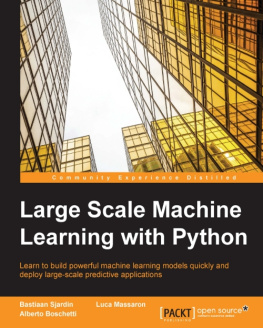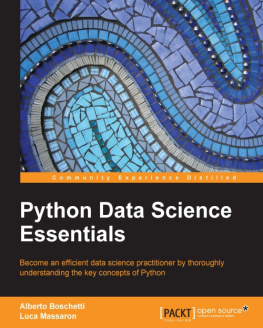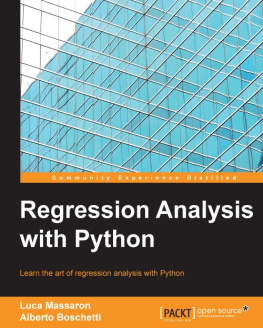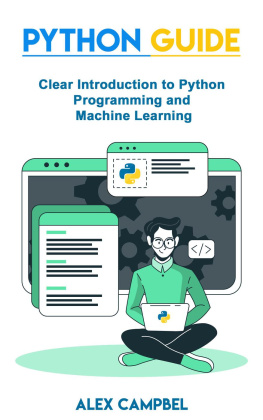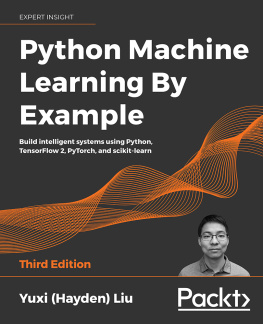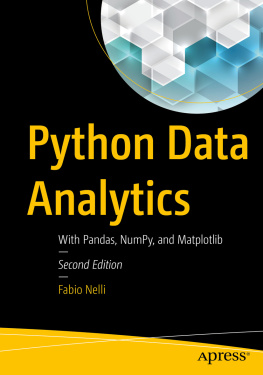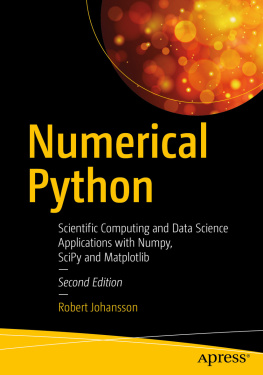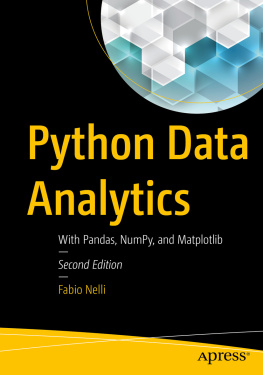Alberto Boschetti - Large Scale Machine Learning with Python
Here you can read online Alberto Boschetti - Large Scale Machine Learning with Python full text of the book (entire story) in english for free. Download pdf and epub, get meaning, cover and reviews about this ebook. year: 2016, publisher: Packt Publishing, genre: Home and family. Description of the work, (preface) as well as reviews are available. Best literature library LitArk.com created for fans of good reading and offers a wide selection of genres:
Romance novel
Science fiction
Adventure
Detective
Science
History
Home and family
Prose
Art
Politics
Computer
Non-fiction
Religion
Business
Children
Humor
Choose a favorite category and find really read worthwhile books. Enjoy immersion in the world of imagination, feel the emotions of the characters or learn something new for yourself, make an fascinating discovery.
- Book:Large Scale Machine Learning with Python
- Author:
- Publisher:Packt Publishing
- Genre:
- Year:2016
- Rating:4 / 5
- Favourites:Add to favourites
- Your mark:
Large Scale Machine Learning with Python: summary, description and annotation
We offer to read an annotation, description, summary or preface (depends on what the author of the book "Large Scale Machine Learning with Python" wrote himself). If you haven't found the necessary information about the book — write in the comments, we will try to find it.
Achieving SVM at scale with SGD -- Feature selection by regularization -- Including non-linearity in SGD -- Trying explicit high-dimensional mappings -- Hyperparameter tuning -- Other alternatives for SVM fast learning -- Nonlinear and faster with Vowpal Wabbit -- Installing VW -- Understanding the VW data format -- Python integration -- A few examples using reductions for SVM and neural nets -- Faster bike-sharing -- The covertype dataset crunched by VW -- Summary -- Chapter 4: Neural Networks and Deep Learning -- The neural network architecture -- What and how neural networks learn -- Choosing the right architecture -- The input layer -- The hidden layer -- The output layer -- Neural networks in action -- Parallelization for sknn -- Neural networks and regularization -- Neural networks and hyperparameter optimization -- Neural networks and decision boundaries -- Deep learning at scale with H2O -- Large scale deep learning with H2O -- Gridsearch on H2O -- Deep learning and unsupervised pretraining -- Deep learning with theanets -- Autoencoders and unsupervised learning -- Autoencoders -- Summary -- Chapter 5: Deep Learning with TensorFlow -- TensorFlow installation -- TensorFlow operations -- GPU computing -- Linear regression with SGD -- A neural network from scratch in TensorFlow -- Machine learning on TensorFlow with SkFlow -- Deep learning with large files - incremental learning -- Keras and TensorFlow installation -- Convolutional Neural Networks in TensorFlow through Keras -- The convolution layer -- The pooling layer -- The fully connected layer -- CNNs with an incremental approach -- GPU Computing -- Summary -- Chapter 6: Classification and Regression Trees at Scale -- Bootstrap aggregation -- Random forest and extremely randomized forest -- Fast parameter optimization with randomized search -- Extremely randomized trees and large datasets
CART and boosting -- Gradient Boosting Machines -- max_depth -- learning_rate -- Subsample -- Faster GBM with warm_start -- Training and storing GBM models -- XGBoost -- XGBoost regression -- XGBoost and variable importance -- XGBoost streaming large datasets -- XGBoost model persistence -- Out-of-core CART with H2O -- Random forest and gridsearch on H2O -- Stochastic gradient boosting and gridsearch on H2O -- Summary -- Chapter 7: Unsupervised Learning at Scale -- Unsupervised methods -- Feature decomposition - PCA -- Randomized PCA -- Incremental PCA -- Sparse PCA -- PCA with H2O -- Clustering - K-means -- Initialization methods -- K-means assumptions -- Selection of the best K -- Scaling K-means - mini-batch -- K-means with H2O -- LDA -- Scaling LDA - memory, CPUs, and machines -- Summary -- Chapter 8: Distributed Environments - Hadoop and Spark -- From a standalone machine to a bunch of nodes -- Why do we need a distributed framework? -- Setting up the VM -- VirtualBox -- Vagrant -- Using the VM -- The Hadoop ecosystem -- Architecture -- HDFS -- MapReduce -- YARN -- Spark -- pySpark -- Summary -- Chapter 9: Practical Machine Learning with Spark -- Setting up the VM for this chapter -- Sharing variables across cluster nodes -- Broadcast read-only variables -- Accumulators write-only variables -- Broadcast and accumulators together - an example -- Data preprocessing in Spark -- JSON files and Spark DataFrames -- Dealing with missing data -- Grouping and creating tables in-memory -- Writing the preprocessed DataFrame or RDD to disk -- Working with Spark DataFrames -- Machine learning with Spark -- Spark on the KDD99 dataset -- Reading the dataset -- Feature engineering -- Training a learner -- Evaluating a learners performance -- The power of the ML pipeline -- Manual tuning -- Cross-validation -- Final cleanup -- Summary
Appendix: Introduction to GPUs and Theano -- GPU computing -- Theano - parallel computing on the GPU -- Installing Theano -- Index Read more...
Abstract: Cover -- Copyright -- Credits -- About the Authors -- About the Reviewers -- www.PacktPub.com -- Table of Contents -- Preface -- Chapter 1: First Steps to Scalability -- Explaining scalability in detail -- Making large scale examples -- Introducing Python -- Scale up with Python -- Scale out with Python -- Python for large scale machine learning -- Choosing between Python 2 and Python 3 -- Installing Python -- Step-by-step installation -- The installation of packages -- Package upgrades -- Scientific distributions -- Introducing Jupyter/IPython -- Python packages -- NumPy -- SciPy -- Pandas -- Scikit-learn -- The matplotlib package -- Gensim -- H2O -- XGBoost -- Theano -- TensorFlow -- The sknn library -- Theanets -- Keras -- Other useful packages to install on your system -- Summary -- Chapter 2: Scalable Learning in Scikit-learn -- Out-of-core learning -- Subsampling as a viable option -- Optimizing one instance at a time -- Building an out-of-core learning system -- Streaming data from sources -- Datasets to try the real thing yourself -- The first example - streaming the bike-sharing dataset -- Using pandas I/O tools -- Working with databases -- Paying attention to the ordering of instances -- Stochastic learning -- Batch gradient descent -- Stochastic gradient descent -- The Scikit-learn SGD implementation -- Defining SGD learning parameters -- Feature management with data streams -- Describing the target -- The hashing trick -- Other basic transformations -- Testing and validation in a stream -- Trying SGD in action -- Summary -- Chapter 3: Fast SVM Implementations -- Datasets to experiment with on your own -- The bike-sharing dataset -- The covertype dataset -- Support Vector Machines -- Hinge loss and its variants -- Understanding the Scikit-learn SVM implementation -- Pursuing nonlinear SVMs by subsampling
Achieving SVM at scale with SGD -- Feature selection by regularization -- Including non-linearity in SGD -- Trying explicit high-dimensional mappings -- Hyperparameter tuning -- Other alternatives for SVM fast learning -- Nonlinear and faster with Vowpal Wabbit -- Installing VW -- Understanding the VW data format -- Python integration -- A few examples using reductions for SVM and neural nets -- Faster bike-sharing -- The covertype dataset crunched by VW -- Summary -- Chapter 4: Neural Networks and Deep Learning -- The neural network architecture -- What and how neural networks learn -- Choosing the right architecture -- The input layer -- The hidden layer -- The output layer -- Neural networks in action -- Parallelization for sknn -- Neural networks and regularization -- Neural networks and hyperparameter optimization -- Neural networks and decision boundaries -- Deep learning at scale with H2O -- Large scale deep learning with H2O -- Gridsearch on H2O -- Deep learning and unsupervised pretraining -- Deep learning with theanets -- Autoencoders and unsupervised learning -- Autoencoders -- Summary -- Chapter 5: Deep Learning with TensorFlow -- TensorFlow installation -- TensorFlow operations -- GPU computing -- Linear regression with SGD -- A neural network from scratch in TensorFlow -- Machine learning on TensorFlow with SkFlow -- Deep learning with large files - incremental learning -- Keras and TensorFlow installation -- Convolutional Neural Networks in TensorFlow through Keras -- The convolution layer -- The pooling layer -- The fully connected layer -- CNNs with an incremental approach -- GPU Computing -- Summary -- Chapter 6: Classification and Regression Trees at Scale -- Bootstrap aggregation -- Random forest and extremely randomized forest -- Fast parameter optimization with randomized search -- Extremely randomized trees and large datasets
CART and boosting -- Gradient Boosting Machines -- max_depth -- learning_rate -- Subsample -- Faster GBM with warm_start -- Training and storing GBM models -- XGBoost -- XGBoost regression -- XGBoost and variable importance -- XGBoost streaming large datasets -- XGBoost model persistence -- Out-of-core CART with H2O -- Random forest and gridsearch on H2O -- Stochastic gradient boosting and gridsearch on H2O -- Summary -- Chapter 7: Unsupervised Learning at Scale -- Unsupervised methods -- Feature decomposition - PCA -- Randomized PCA -- Incremental PCA -- Sparse PCA -- PCA with H2O -- Clustering - K-means -- Initialization methods -- K-means assumptions -- Selection of the best K -- Scaling K-means - mini-batch -- K-means with H2O -- LDA -- Scaling LDA - memory, CPUs, and machines -- Summary -- Chapter 8: Distributed Environments - Hadoop and Spark -- From a standalone machine to a bunch of nodes -- Why do we need a distributed framework? -- Setting up the VM -- VirtualBox -- Vagrant -- Using the VM -- The Hadoop ecosystem -- Architecture -- HDFS -- MapReduce -- YARN -- Spark -- pySpark -- Summary -- Chapter 9: Practical Machine Learning with Spark -- Setting up the VM for this chapter -- Sharing variables across cluster nodes -- Broadcast read-only variables -- Accumulators write-only variables -- Broadcast and accumulators together - an example -- Data preprocessing in Spark -- JSON files and Spark DataFrames -- Dealing with missing data -- Grouping and creating tables in-memory -- Writing the preprocessed DataFrame or RDD to disk -- Working with Spark DataFrames -- Machine learning with Spark -- Spark on the KDD99 dataset -- Reading the dataset -- Feature engineering -- Training a learner -- Evaluating a learners performance -- The power of the ML pipeline -- Manual tuning -- Cross-validation -- Final cleanup -- Summary
Appendix: Introduction to GPUs and Theano -- GPU computing -- Theano - parallel computing on the GPU -- Installing Theano -- Index
Alberto Boschetti: author's other books
Who wrote Large Scale Machine Learning with Python? Find out the surname, the name of the author of the book and a list of all author's works by series.

